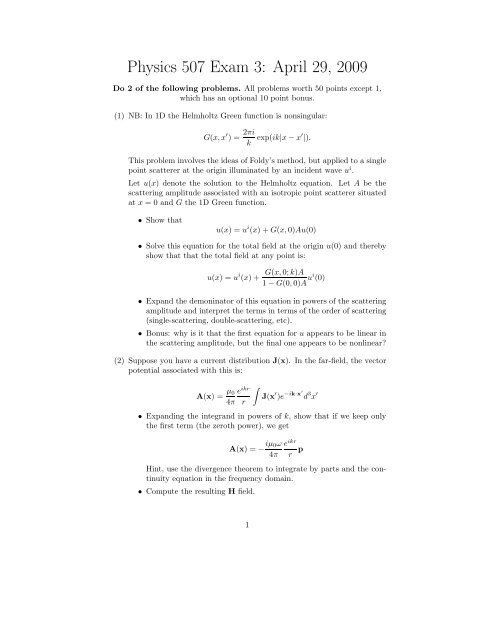sample exam questions
sample exam questions
sample exam questions
You also want an ePaper? Increase the reach of your titles
YUMPU automatically turns print PDFs into web optimized ePapers that Google loves.
Physics 507 Exam 3: April 29, 2009<br />
Do 2 of the following problems. All problems worth 50 points except 1,<br />
which has an optional 10 point bonus.<br />
(1) NB: In 1D the Helmholtz Green function is nonsingular:<br />
G(x, x ′ ) = 2πi<br />
k exp(ik|x − x′ |).<br />
This problem involves the ideas of Foldy’s method, but applied to a single<br />
point scatterer at the origin illuminated by an incident wave u i .<br />
Let u(x) denote the solution to the Helmholtz equation. Let A be the<br />
scattering amplitude associated with an isotropic point scatterer situated<br />
at x = 0 and G the 1D Green function.<br />
• Show that<br />
u(x) = u i (x) + G(x, 0)Au(0)<br />
• Solve this equation for the total field at the origin u(0) and thereby<br />
show that that the total field at any point is:<br />
u(x) = u i (x) +<br />
G(x, 0; k)A<br />
1 − G(0, 0)A ui (0)<br />
• Expand the demoninator of this equation in powers of the scattering<br />
amplitude and interpret the terms in terms of the order of scattering<br />
(single-scattering, double-scattering, etc).<br />
• Bonus: why is it that the first equation for u appears to be linear in<br />
the scattering amplitude, but the final one appears to be nonlinear?<br />
(2) Suppose you have a current distribution J(x). In the far-field, the vector<br />
potential associated with this is:<br />
A(x) = µ 0 e ikr ∫<br />
4π r<br />
J(x ′ )e −ik·x′ d 3 x ′<br />
• Expanding the integrand in powers of k, show that if we keep only<br />
the first term (the zeroth power), we get<br />
A(x) = − iµ 0ω<br />
4π<br />
e ikr<br />
r p<br />
Hint, use the divergence theorem to integrate by parts and the continuity<br />
equation in the frequency domain.<br />
• Compute the resulting H field.<br />
1
(3) Consider a thick non-magnetic slab of conductivity σ, whose normal is<br />
in the z direction illuminated by a plane EM wave propagating in the z<br />
direction. Let the peak amplitudes of this wave be E 0 and B 0 . For large<br />
σ the real and imaginary parts of the wavevector are equal:<br />
√<br />
k ′ = k ′′ ωσµ0<br />
≈<br />
2<br />
• Compute the Poynting in the slab vector averaged over one period.<br />
• Suppose the conductivity of the slab goes to infinity. What is the<br />
time averaged Poynting vector everywhere in space?<br />
(4) Consider the semi-classical model for an electron bound by a linear restoring<br />
force and subject to a time-varying electric field E = E 0 e −iωt . Let K<br />
denote the spring constant and γ the damping constant.<br />
• Derive the equations of motion for the electron position x.<br />
• This model applies to plasmas, in which case the electron is not<br />
bound, so K = 0. Let ρ e be the electron density. Derive an expression<br />
for the conductivity of plasmas. Hint: you may assume Ohm’s law<br />
applies.<br />
• For dilute plasmas, collisions are neglible, so you can set γ = 0. Show<br />
that in this case the conductivity is purely imaginary.<br />
2
















